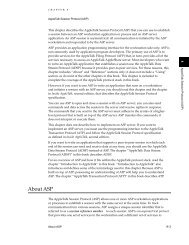URL Loading System Programming Guide - Apple Developer
URL Loading System Programming Guide - Apple Developer
URL Loading System Programming Guide - Apple Developer
Create successful ePaper yourself
Turn your PDF publications into a flip-book with our unique Google optimized e-Paper software.
Authentication Challenges and TLS Chain Validation<br />
Responding to an Authentication Challenge<br />
●<br />
●<br />
●<br />
●<br />
HTTP basic authentication (NS<strong>URL</strong>AuthenticationMethodHTTPBasic) requires a user name and<br />
password. Prompt the user for the necessary information and create an NS<strong>URL</strong>Credential object with<br />
credentialWithUser:password:persistence:.<br />
HTTP digest authentication (NS<strong>URL</strong>AuthenticationMethodHTTPDigest), like basic authentication,<br />
requires a user name and password. (The digest is generated automatically.) Prompt the user for the<br />
necessary information and create an NS<strong>URL</strong>Credential object with<br />
credentialWithUser:password:persistence:.<br />
Client certificate authentication (NS<strong>URL</strong>AuthenticationMethodClientCertificate) requires the<br />
system identity and all certificates needed to authenticate with the server. Create an NS<strong>URL</strong>Credential<br />
object with credentialWithIdentity:certificates:persistence:.<br />
Server trust authentication (NS<strong>URL</strong>AuthenticationMethodServerTrust) requires a trust provided by<br />
the protection space of the authentication challenge. Create an NS<strong>URL</strong>Credential object with<br />
credentialForTrust:.<br />
After you’ve created the NS<strong>URL</strong>Credential object:<br />
●<br />
●<br />
For NS<strong>URL</strong>Session, pass the object to the authentication challenge’s sender using the provided completion<br />
handler block.<br />
For NS<strong>URL</strong>Connection and NS<strong>URL</strong>Download, pass the object to the authentication challenge’s sender<br />
with useCredential:forAuthenticationChallenge:.<br />
Continuing Without Credentials<br />
If the delegate chooses not to provide a credential for the authentication challenge, it can attempt to continue<br />
without one.<br />
●<br />
For NS<strong>URL</strong>Session, pass one of the following values to the provided completion handler block:<br />
NS<strong>URL</strong>SessionAuthChallengePerformDefaultHandling processes the request as though the<br />
delegate did not provide a delegate method to handle the challenge.<br />
NS<strong>URL</strong>SessionAuthChallengeRejectProtectionSpace rejects the challenge. Depending on the<br />
authentication types allowed by the server’s response, the <strong>URL</strong> loading class may call this delegate method<br />
more than once, for additional protection spaces.<br />
●<br />
For NS<strong>URL</strong>Connection and NS<strong>URL</strong>Download, call<br />
continueWithoutCredentialsForAuthenticationChallenge: on [challenge sender].<br />
Depending on the protocol implementation, continuing without credentials may either cause the connection<br />
to fail, resulting in a connectionDidFailWithError: message, or return alternate <strong>URL</strong> contents that<br />
don’t require authentication.<br />
2013-10-22 | Copyright © 2003, 2013 <strong>Apple</strong> Inc. All Rights Reserved.<br />
55
















